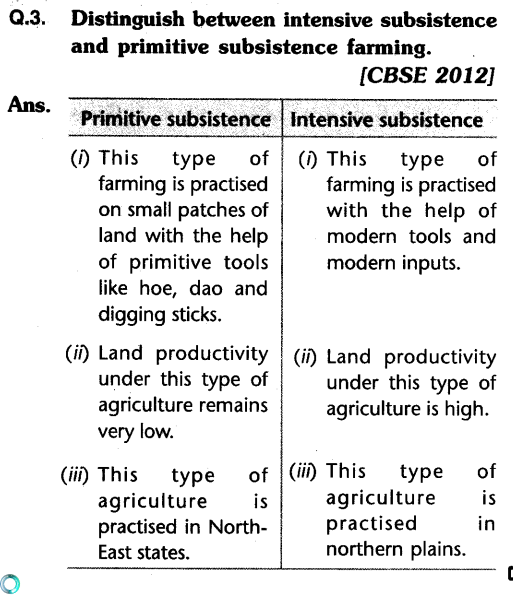Ecological Impacts of Commercial Farming vs Subsistence Farming: What You Required to Know
Ecological Impacts of Commercial Farming vs Subsistence Farming: What You Required to Know
Blog Article
Discovering the Distinctions Between Commercial Farming and Subsistence Farming Practices
The duality between commercial and subsistence farming techniques is marked by differing purposes, functional ranges, and source use, each with profound ramifications for both the atmosphere and culture. On the other hand, subsistence farming highlights self-sufficiency, leveraging standard techniques to sustain home requirements while nurturing community bonds and social heritage.
Economic Goals
Financial objectives in farming practices usually dictate the approaches and range of operations. In commercial farming, the primary financial goal is to take full advantage of revenue.
In contrast, subsistence farming is primarily oriented in the direction of fulfilling the immediate needs of the farmer's household, with surplus production being very little. The financial objective right here is usually not benefit maximization, yet instead self-sufficiency and danger reduction. These farmers usually operate with restricted resources and count on typical farming strategies, customized to regional ecological conditions. The primary goal is to ensure food protection for the family, with any type of excess fruit and vegetables offered locally to cover standard necessities. While business farming is profit-driven, subsistence farming is focused around sustainability and resilience, mirroring a basically different collection of economic imperatives.

Range of Workflow
The difference between commercial and subsistence farming becomes particularly noticeable when thinking about the scale of operations. The scale of commercial farming enables for economic climates of scale, resulting in decreased prices per system with mass production, raised performance, and the capacity to invest in technological advancements.
In raw contrast, subsistence farming is usually small, concentrating on generating simply sufficient food to satisfy the immediate demands of the farmer's family or regional neighborhood. The acreage included in subsistence farming is typically restricted, with less accessibility to modern-day innovation or mechanization. This smaller range of procedures mirrors a reliance on traditional farming strategies, such as manual work and straightforward tools, causing lower productivity. Subsistence ranches prioritize sustainability and self-sufficiency over earnings, with any kind of excess normally traded or traded within local markets.
Source Application
Business farming, identified by massive operations, usually utilizes sophisticated technologies and mechanization to enhance the usage of sources such as land, water, and fertilizers. Precision farming is progressively adopted in commercial farming, utilizing information analytics and satellite innovation to keep track of plant wellness and optimize resource application, additional boosting return and resource effectiveness.
On the other hand, subsistence farming operates a much smaller sized scale, mostly to meet the prompt requirements of the farmer's house. commercial farming vs subsistence farming. Resource utilization in subsistence farming is frequently restricted by financial restraints and a dependence on typical methods. Farmers usually utilize hand-operated labor and natural try this deposits readily available in your area, such as rain and organic compost, to grow their plants. The focus gets on sustainability and self-direction instead than making best use of result. As a result, subsistence farmers may face challenges in resource management, consisting of minimal access to boosted seeds, fertilizers, and irrigation, which can restrict their capacity to boost productivity and earnings.
Ecological Impact

Alternatively, subsistence farming, practiced on a smaller range, normally utilizes conventional techniques that are extra in consistency with the surrounding environment. While subsistence farming normally has a reduced environmental footprint, it is not without challenges.
Social and Cultural Implications
Farming methods are deeply linked with the social and social textile of areas, influencing and mirroring their worths, practices, and financial frameworks. In subsistence farming, the emphasis gets on cultivating sufficient food to fulfill the immediate demands of the farmer's family, often promoting a solid feeling of community and shared obligation. Such practices are deeply rooted in neighborhood customs, with knowledge gave via generations, therefore maintaining social heritage and enhancing common ties.
Alternatively, industrial farming is mainly driven by market demands and success, commonly causing a change towards monocultures and massive operations. This technique can bring about the More Help disintegration of standard farming techniques and cultural identities, as regional customizeds and expertise are replaced by standard, industrial approaches. The emphasis on effectiveness and earnings can occasionally decrease the social communication located in subsistence communities, as economic transactions change community-based exchanges.
The dichotomy between these farming practices highlights the more comprehensive social implications of farming options. While subsistence farming supports social connection and community interdependence, commercial farming straightens with globalization and financial growth, commonly at the price of typical social frameworks and cultural diversity. commercial farming vs subsistence farming. Balancing these elements continues to be a click over here crucial obstacle for sustainable farming advancement
Verdict
The evaluation of industrial and subsistence farming methods discloses substantial distinctions in purposes, scale, source use, ecological effect, and social ramifications. On the other hand, subsistence farming emphasizes self-sufficiency, utilizing traditional methods and regional sources, therefore promoting cultural preservation and community cohesion.
The duality in between industrial and subsistence farming practices is marked by varying goals, functional scales, and resource usage, each with profound effects for both the setting and society. While commercial farming is profit-driven, subsistence farming is focused around sustainability and durability, mirroring a fundamentally different set of financial imperatives.
The difference between commercial and subsistence farming comes to be specifically apparent when considering the scale of operations. While subsistence farming supports cultural continuity and neighborhood connection, industrial farming straightens with globalization and economic growth, usually at the cost of conventional social structures and cultural variety.The examination of commercial and subsistence farming practices exposes considerable distinctions in purposes, scale, resource usage, ecological impact, and social ramifications.
Report this page